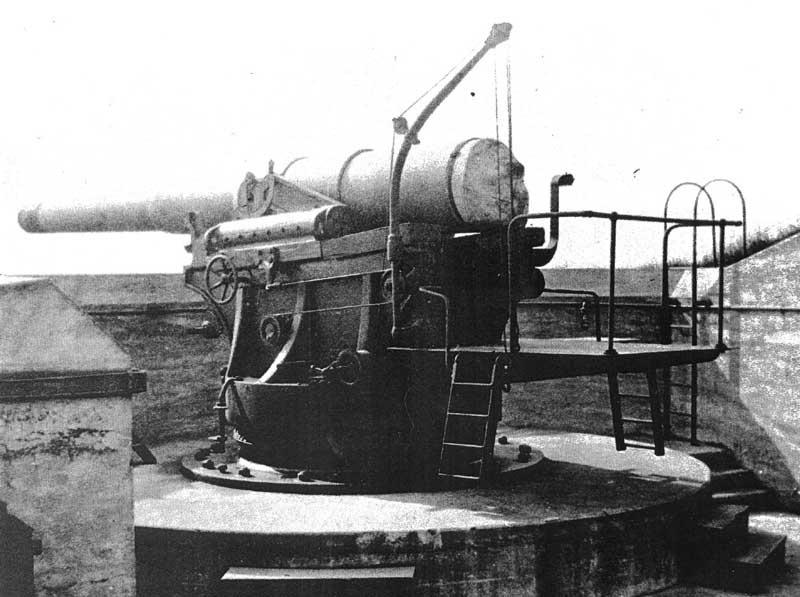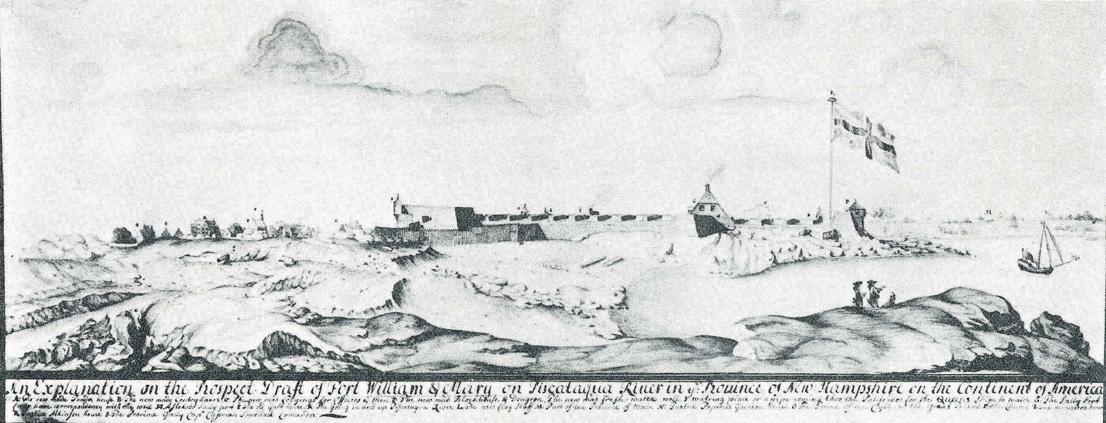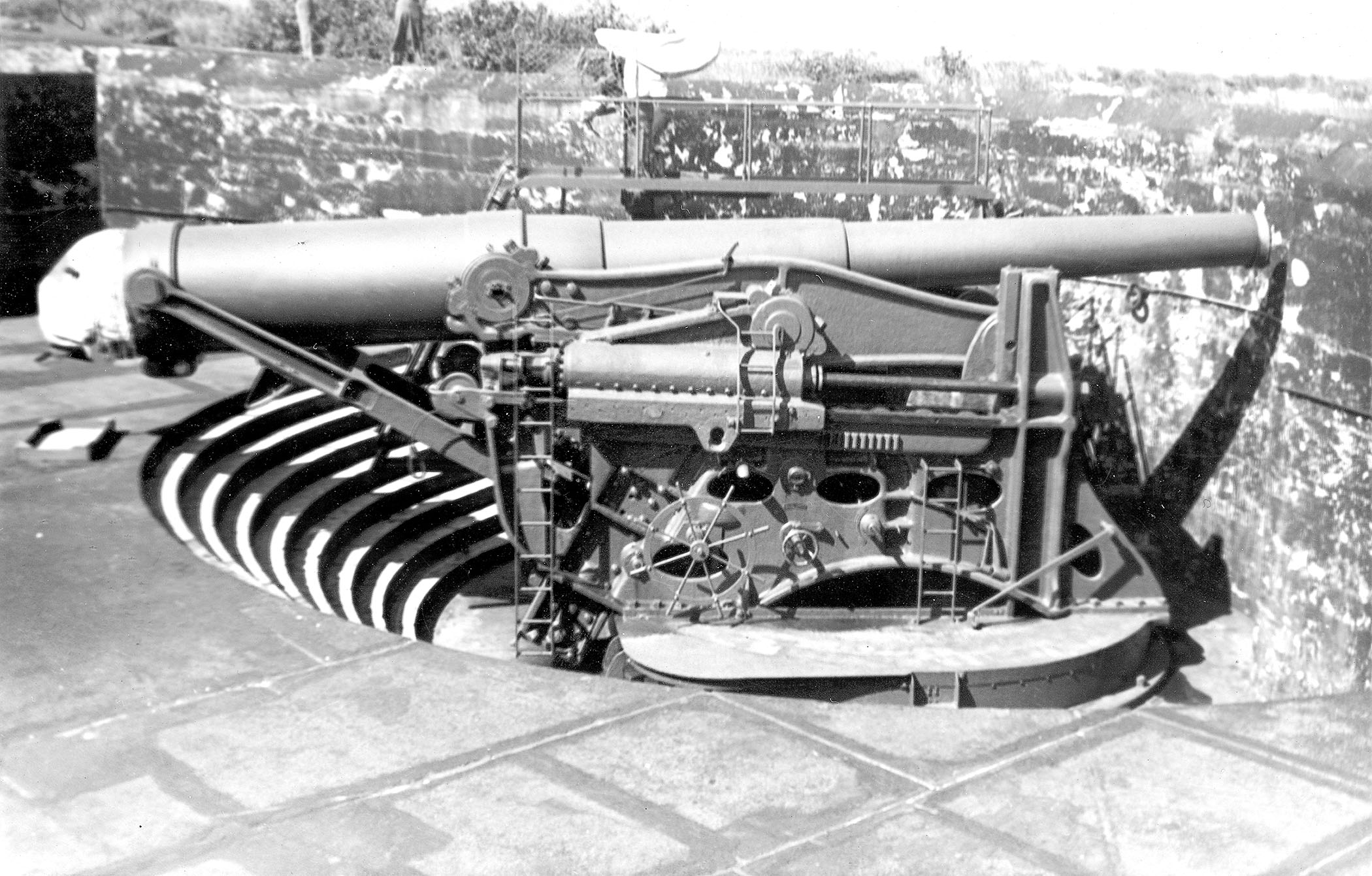|
8-inch Gun M1888
The 8-inch gun M1888 (203 mm) was a U.S. Army Coast Artillery Corps gun, initially deployed 1898–1908 in about 75 fixed emplacements, usually on a disappearing carriage. During World War I, 37 or 47 of these weapons (references vary) were removed from fixed emplacements or from storage to create a railway gun version, the 8-inch Gun M1888MIA1 Barbette carriage M1918 on railway car M1918MI, converted from the fixed coast defense mountings and used during World War I and World War II. History The M1888 gun was a coastal artillery gun initially deployed as part of the Endicott system of fortifications. The first nine were deployed on the M1892 barbette carriage in 1898, but the improved M1894 and M1896 disappearing carriages soon became available, and approximately 64 additional weapons were deployed on these carriages by 1908. An "emergency" converted Rodman carriage was also used during the Spanish–American War in 1898 to quickly arm 21 emplacements with the modern ... [...More Info...] [...Related Items...] OR: [Wikipedia] [Google] [Baidu] |
Railway Gun
A railway gun, also called a railroad gun, is a large artillery piece, often surplus naval artillery, mounted on, transported by, and fired from a specially designed railroad car, railway wagon. Many countries have built railway guns, but the best-known are the large Krupp-built pieces used by German Reich, Germany in World War I and World War II. Smaller guns were often part of an armoured train. Only able to be moved where there were good tracks, which could be destroyed by artillery bombardment or airstrike, railway guns were phased out after World War II. Design considerations The design of a railway gun has three firing issues over and above those of an ordinary artillery piece to consider. Namely how the gun is going to be traversed – i.e. moved from side to side to aim; how the horizontal component of the recoil force will be absorbed by the gun's carriage and how the vertical recoil force will be absorbed by the ground. Methods of traverse The first method of ... [...More Info...] [...Related Items...] OR: [Wikipedia] [Google] [Baidu] |
Board Of Fortifications
Several boards have been appointed by US presidents or Congress to evaluate the US defensive fortifications, primarily coastal defenses near strategically important harbors on the US shores, its territories, and its protectorates. Endicott Board In 1885 US President Grover Cleveland appointed a joint Army, Navy and civilian board, headed by Secretary of War William Crowninshield Endicott, known as the Board of Fortifications (now usually referred to simply as the Endicott Board). The findings of the Board in its 1886 report illustrated a grim picture of neglect of America's coast defenses and recommended a massive $127 million construction program for a series of new forts with breech-loading cannons, mortars, floating batteries, and submarine mines for some 29 locations on the US coast. Coast Artillery fortifications built between 1885 and 1905 are often referred to as Endicott Period fortifications. Prior efforts at harbor defense construction had ceased in the 1870s. Si ... [...More Info...] [...Related Items...] OR: [Wikipedia] [Google] [Baidu] |
Harbor Defenses Of Long Island Sound
The Harbor Defenses of Long Island Sound was a United States Army Coast Artillery Corps harbor defense command. It coordinated the coast defenses of Long Island Sound and Connecticut from 1895 to 1950, beginning with the Endicott program. These included both coast artillery forts (all but two on islands in the sound) and underwater minefields. The area defended included the approach via the Sound to New York City, the port cities and manufacturing centers of New London, New Haven, and Bridgeport, and eventually included the submarine base and shipyard in Groton. The command originated circa 1900 as an Artillery District, was renamed Coast Defenses of Long Island Sound in 1913, and again renamed Harbor Defenses of Long Island Sound in 1925.Stanton, pp. 455-481Rinaldi, pp. 165-166Berhow, pp. 430-434 History Early Long Island Sound forts Colonial period Connecticut appears to have had few coastal fortifications in the colonial era. Unnamed forts are referred to in New Haven at ... [...More Info...] [...Related Items...] OR: [Wikipedia] [Google] [Baidu] |
Harbor Defenses Of New Bedford
The Harbor Defenses of New Bedford was a United States Army Coast Artillery Corps harbor defense command. It coordinated the coast defenses of New Bedford, Massachusetts and the nearby Cape Cod Canal from 1900 to 1950, beginning with the Endicott program. These included a coast artillery fort (Fort Rodman, a.k.a. Fort Taber) and an underwater minefield. The command originated circa 1900 as the New Bedford Artillery District, was renamed Coast Defenses of New Bedford in 1913, and again renamed Harbor Defenses of New Bedford in 1925.Stanton, pp. 455-481, 484Rinaldi, pp. 165-166Berhow, p. 430-434 History Early New Bedford forts ;American Revolution through War of 1812 Two forts were built in the New Bedford area in the American Revolution, a 6-gun (possibly 11-gun)Roberts, p. 407 unnamed fort (later named Fort Phoenix) in 1775 in what is now Fairhaven, and the 10-gun Acushnet Fort in 1776 at an uncertain location, possibly on Clark's Point at the site of the later Fort Rodm ... [...More Info...] [...Related Items...] OR: [Wikipedia] [Google] [Baidu] |
Harbor Defenses Of Portsmouth
The Harbor Defenses of Portsmouth was a United States Army Coast Artillery Corps harbor defense command. It coordinated the coast defenses of Portsmouth, New Hampshire and the nearby Portsmouth Naval Shipyard in Kittery, Maine from 1900 to 1950, both on the Piscataqua River, beginning with the Endicott program. These included both coast artillery forts and underwater minefields. The command originated circa 1900 as the Portsmouth Artillery District, was renamed Coast Defenses of Portsmouth in 1913, and again renamed Harbor Defenses of Portsmouth in 1925.Stanton, pp. 455-481Rinaldi, pp. 165-166Berhow, p. 430-434 History Early Portsmouth forts The first fort in the Portsmouth area was Fort William and Mary (called The Castle until circa 1692) in New Castle,Roberts, pp. 498-499 initially garrisoned before 1632 and perhaps the oldest continuously fortified site in the British colonies that later became the United States. In 1680 another small fort was established on the site of ... [...More Info...] [...Related Items...] OR: [Wikipedia] [Google] [Baidu] |
Harbor Defenses Of Portland
The Harbor Defenses of Portland was a United States Army Coast Artillery Corps harbor defense command. It coordinated the coast defenses of Portland, Maine, the mouth of the Kennebec River, and surrounding areas from 1895 to 1950, beginning with the Endicott program. These included both coast artillery forts and underwater minefields. The command originated circa 1895 as the Portland Artillery District, was renamed Coast Defenses of Portland in 1913, and again renamed Harbor Defenses of Portland in 1925.Rinaldi, pp. 165-166Berhow, p. 430-434Stanton, pp. 455-481 Coast Defenses of the Kennebec The Kennebec coast defense command may have originated as the Kennebec Artillery District with the establishment of Endicott program minefield support facilities in the 1890s at the Civil War-era Fort Popham in Phippsburg, and deployment of mines there during the Spanish–American War. However, it is unclear from references whether the Coast Defenses of the Kennebec (as it was pr ... [...More Info...] [...Related Items...] OR: [Wikipedia] [Google] [Baidu] |
Harbor Defense Command
A Harbor Defense Command was a military organization of the United States Army Coast Artillery Corps designated in 1925 from predecessor organizations dating from circa 1895. It consisted of the forts, controlled underwater minefields, and other coastal defenses of a particular harbor or river. Harbor Defense Commands, along with the similar Coast Artillery Corps, were disestablished in 1950. History These commands originated as Artillery Districts, to control groups of forts constructed under the Endicott Program beginning in 1895. A 1909 reference shows that districts could include (depending on size) a Battle Command (later Fort Command), Fire Command, Mine Command, and Battery Commands. Mine planter vessels were also attached to these commands to plant and maintain controlled minefields. In 1913 the districts were redesignated as Coast Defense Commands, called "Coast Defenses of..." the area protected.Rinaldi, pp. 165-166 At this time Coast Artillery Districts became regional ... [...More Info...] [...Related Items...] OR: [Wikipedia] [Google] [Baidu] |
12-inch Coast Defense Mortar
The 12-inch coast defense mortar was a weapon of caliber emplaced during the 1890s and early 20th century to defend US harbors from seaborne attack. In 1886, when the Endicott Board set forth its initial plan for upgrading the coast defenses of the United States, it relied primarily on mortars, not guns, to defend American harbors. "Sea-Coast Mortar Fire", Report of a Board, in ''Journal of the United States Artillery'', Vol. 7, No. 3, 1897. Over the years, provision was made for fortifications that would mount some 476 of these weapons, although not all of these tubes were installed. Ninety-one of these weapons were remounted as railway artillery in 1918-1919, but this was too late to see action in World War I. The railway mortars were only deployed in small quantities, and none overseas. The fixed mortars in the Philippines saw action in the Japanese invasion in World War II. All of the fixed mortars (except four) in the United States were scrapped by 1944, as new weapons replac ... [...More Info...] [...Related Items...] OR: [Wikipedia] [Google] [Baidu] |
12-inch Gun M1895
The 12-inch coastal defense gun M1895 (305 mm) and its variants the M1888 and M1900 were large coastal artillery pieces installed to defend major American seaports between 1895 and 1945. For most of their history they were operated by the United States Army Coast Artillery Corps. Most were installed on Disappearing gun, disappearing carriages, with early installations on low-angle barbette mountings. From 1919, 19 long-range two-gun batteries were built using the M1895 on an M1917 long-range barbette carriage. Almost all of the weapons not in the Philippines were scrapped during and after World War II. History In 1885, William Crowninshield Endicott, William C. Endicott, President of the United States, President Grover Cleveland's secretary of war, was tasked with creating the Board of Fortifications to review seacoast defenses. The findings of the board illustrated a grim picture of existing defenses, and in its 1886 report recommended a massive $127 million construction progr ... [...More Info...] [...Related Items...] OR: [Wikipedia] [Google] [Baidu] |
10-inch Gun M1895
The 10-inch Gun M1895 (254 mm) and its variants the M1888 and M1900 were large coastal artillery pieces installed to defend major American seaports between 1895 and 1945. For most of their history they were operated by the United States Army Coast Artillery Corps. Most were installed on disappearing carriages, with early installations on barbette mountings. All of the weapons not in the Philippines (except four guns in Canada) were scrapped during World War II. Two of the surviving weapons were relocated from the Philippines to Fort Casey in Washington state in the 1960s. History In 1885, William C. Endicott, President Grover Cleveland's Secretary of War, was tasked with creating the Board of Fortifications to review seacoast defenses. The findings of the board illustrated a grim picture of existing defenses in its 1886 report and recommended a massive $127 million construction program of breech-loading cannons, mortars, floating batteries, and submarine mines for some ... [...More Info...] [...Related Items...] OR: [Wikipedia] [Google] [Baidu] |
Philippines Campaign (1941–1942)
The Philippines campaign ( fil, Kampanya sa Pilipinas, es, Campaña en las Filipinas del Ejercito Japonés, ja, フィリピンの戦い, Firipin no Tatakai), also known as the Battle of the Philippines ( fil, Labanan sa Pilipinas) or the Fall of the Philippines, was from December 8, 1941, to May 8, 1942, the invasion of the Philippines by the Empire of Japan and the defense of the islands by United States and the Philippine Armies during World War II. The Japanese launched the invasion by sea from Formosa, over north of the Philippines. The defending forces outnumbered the Japanese by a ratio of 3:2 but were a mixed force of non-combat-experienced regular, national guard, constabulary and newly created Commonwealth units. The Japanese used first-line troops at the outset of the campaign, and by concentrating their forces, they swiftly overran most of Luzon during the first month. The Japanese high command, believing that they had won the campaign, made a strategic decision ... [...More Info...] [...Related Items...] OR: [Wikipedia] [Google] [Baidu] |
Parapet
A parapet is a barrier that is an extension of the wall at the edge of a roof, terrace, balcony, walkway or other structure. The word comes ultimately from the Italian ''parapetto'' (''parare'' 'to cover/defend' and ''petto'' 'chest/breast'). Where extending above a roof, a parapet may simply be the portion of an exterior wall that continues above the edge line of the roof surface, or may be a continuation of a vertical feature beneath the roof such as a fire wall or party wall. Parapets were originally used to defend buildings from military attack, but today they are primarily used as guard rails, to conceal rooftop equipment, reduce wind loads on the roof, and to prevent the spread of fires. In the Bible the Hebrews are obligated to build a parapet on the roof of their houses to prevent people falling (Deuteronomy 22:8). Parapet types Parapets may be plain, embattled, perforated or panelled, which are not mutually exclusive terms. *Plain parapets are upward extensions of ... [...More Info...] [...Related Items...] OR: [Wikipedia] [Google] [Baidu] |











